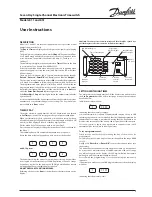
NOVUS AUTOMATION
1/2
TIMER TM-619
PROGRAMMABLE TIME INTERRUPTERS - USER GUIDE V4.0x D
1. OPERATING FEATURE
The Programmable Time Interrupters NOVUS are electronic devices
that permit switching electrical loads (alarm, appliances, etc.) at
programmed time intervals with good accuracy.
Their microprocessor let you create at most eight (8) ON/OFF
programs, which can switch electrical loads at specifics moments
throughout the week.
They have a battery, that give to the TIMER the feature of hold the
programs and run the internal clock for many weeks, even in case of
power outage.
The output is consist of a relay with the terminals NO, COM and NC
(SPDT) available for user. In power outage this relay will not switch,
letting the output inoperative.
2. SPECIFICATIONS
•
POWER: de 12 Vdc, 24 Vdc, 110 Vac or 240 Vac, 50/60 Hz; (see
identification tag); no polarity of the terminals.
•
Switching low interval: 1 minute;
•
OUTPUT: Relay 16 A / 250 Vac, resistive; 8 A / 250 Vac, inductive;
•
Operational temperature: 0 to 60 °C;
•
Storage temperature: -10 to 75 °C;
•
Light indicator for output on (when powered);
•
Proper for be fixed with screw.
3. OPERATIONS MODES
There are three operation modes: ON, AUTO e OFF, select through
the MANUAL key. When the MANUAL key is pressed, observe that
the indicator (line) on the screen move upon the words
ON/AUTO/OFF:
•
MODO ON: When the indicator is upon ON the output turn on
immediately and keep this status while in ON mode.
•
MODO OFF: When the indicator is upon OFF the output turn off
immediately and keep this status while in OFF mode.
•
MODO AUTO: When the indicator is upon AUTO the output turn
on and turn off based on the programs.
When the TIMER isn’t powered, it turns off the output permanently.
4. UPDATING DAY/HOUR/MINUTE
Keep pressed the CLOCK key, then press:
•
DAY: to update the indicated day of week;
•
HOUR: to update the indicated hour;
•
MIN: to update the indicated minutes.
NOTE 1: The terms MO, TU, WE, TH, FR, SA e SU, correspond to
the weekdays in English:
MO= Monday;
TU= Tuesday; WE= Wednesday;
TH= Thursday;
FR= Friday; SA=Saturday;
SU= Sunday;
5. DETERMINING THE ON/OFF CYCLES
Press the TIMER key to access and configure the ON/OFF
programs. The program number, which is at editing, is showed on the
left side of the screen. See Fig. 04. The first edit refers to the
program 1 and determine the moment to turn on the output. Note that
the message ON is showed upon the program number.
•
Press DAY to determine the day which the output should turn on.
Observe that the indication of the weekdays is changed at each
time that DAY key is pressed:
•
Mo, Tu, We, Th, Fr, Sa, Su (everyday)
•
Mo (any day of the week);
•
Tu (Tuesday);
•
We (Wednesday);
•
Th (Thursday);
•
Fr (Friday);
•
Sa (Saturday);
•
Su (Sunday);
•
Mo, Tu, We, Th, Fr (business days);
•
Sa, Su (weekend);
•
Mo, Tu, We, Th, Fr, Sa (business days more Saturday);
•
Mo, Tu, We (Monday, Tuesday and Wednesday);
•
Th, Fr, Sa (Thursday, Friday and Saturday);
•
Mo, We, Fr (Monday, Wednesday and Friday);
•
Tu, Th, Sa (Tuesday, Thursday and Saturday);
•
Press the HOUR key to determine the hour on the chosen days,
in which the output turns on.
•
Press the MIN key to determine the minutes.
Press the TIMER key again to determine the moment to turn off the
output on the program 1. Note that the message OFF upon the
program number. The programming of day, hour and minute is made
identical of the programming of turn ON, showed before:
•
Press DAY key to determine the days when the output is turned
off.
•
Press the HOUR key to determine the hour when the output turns
off.
•
Press the MIN key to determine the minutes.
Press the TIMER key again and the program number displayed will
change to 2, indicating that the following adjusts refer to program 2.
Configure the program 2 as the instruction above. Then access and
determine the other programs, in a total eight programs.
These programs will be used by the TIMER when the operation
mode selected is AUTO. In the time programmed to ON, the output
turns on. In the time programmed to OFF, the output turns off.
In the case of overlapping programs, the output will act like the
example showed at the Fig. 01. When it’s already on, and came a
time when some program turn off, the output turn off. When came a
time in some program when turn on, the output doesn’t change.




















